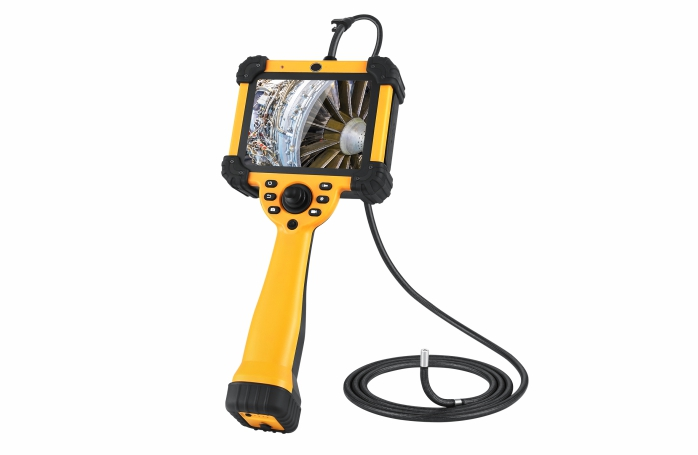Want to know more?
Don't miss any product updates on our industrial borescopes

Industrial borescope
solution service provider
Company Address
Office : 18F, Pingshanshouzuo, Pingshan District, Shenzhen,Guangdong
Contact Info
Ph: +86-0755-89588241

The application of industrial endoscopes in the petrochemical industry has penetrated into core links such as equipment inspection, safety maintenance and efficiency improvement, and has become a key tool to ensure production safety and stability. The following is an analysis from three aspects: application scenarios, technical advantages and typical cases:

Pipeline and pressure vessel inspection
Internal corrosion and crack detection:Petrochemical pipelines transport high temperature, high pressure, corrosive media for a long time, which is prone to inner wall corrosion, cracks and sediment blockage. Industrial endoscopes can penetrate deep into the pipeline and capture defect images in real time through high-resolution cameras (such as the 30-meter insertion tube of the IPLEX GAir video endoscope), and accurately locate problems with LED lighting.
Weld quality verification:Detect the integrity of pressure vessel welds to avoid leakage accidents caused by welding defects.
Case:A company used an endoscope to inspect underground high-pressure pipelines and discovered multiple early corrosion pits, which were repaired in time to avoid environmental pollution caused by leakage.
Tank and reactor inspection
Nondestructive testing of tank inner wall:Tanks storing flammable, explosive, toxic and hazardous substances need to be regularly inspected for corrosion and leakage on the tank wall and bottom. Industrial endoscopes can achieve all-round, no-dead-angle inspections, such as capturing tank damage through high-resolution cameras and efficiently managing inspection results in combination with data storage functions (such as WIFI/SD cards).
Reactor internal structure monitoring:Monitor the temperature, pressure and material status in the reactor to ensure the stability of the reaction process. For example, detect the corrosion of the heat exchanger tubes to detect the failure risk caused by coating shedding in advance.
Valve and compressor inspection
Valve tightness test:Detect valve sealing surface wear, cracks and other defects to ensure its reliability.
Compressor internal wear monitoring:Observe the wear status of bearings, cylinders and piston rings to avoid production interruptions due to equipment failure.
Spill Response
Quickly locate the source of the leak: After a leak occurs, the endoscope can quickly enter narrow or dangerous areas (such as underground pipelines, inside reactors), lock the leak point, shorten the repair time and reduce economic losses.
Non-destructive testing
Internal inspection can be completed without disassembling the equipment, avoiding damage to the equipment caused by traditional methods and reducing maintenance costs.
High-precision imaging and flexibility
Using CMOS sensor or fiber optic imaging technology, it can capture tiny defects of 0.1mm level.
Ultra-thin pipe diameter design (such as 1.2mm) and 360° steering system are suitable for complex pipelines and narrow space inspections.
Real-time monitoring and data analysis
Supports image transmission, video recording and data storage functions, facilitating remote collaboration and long-term analysis. For example, through the real-time video stream of the endoscope, experts can remotely guide on-site inspections.
Significant cost-effectiveness
Reduce equipment downtime, extend service life, and reduce comprehensive maintenance costs. According to statistics, a petrochemical company reduced equipment failure rate by 30% and annual maintenance costs by 20% through endoscope inspection.
Tank inner surface defect detection
Case: A petrochemical enterprise used an industrial endoscope to inspect the inner surface of a storage tank and found many tiny corrosion spots and cracks. Through timely repairs, a major leakage accident was avoided and the safety of the surrounding environment was guaranteed.
Effect: Detection efficiency increased by 50% and cost reduced by 40%.
Internal inspection of long-distance pipelines
Case: In a cross-provincial natural gas pipeline inspection, an endoscope was used in conjunction with a robot crawler to complete internal inspections of tens of kilometers of pipelines, with a defect recognition rate of 98%.
Effect: Discover multiple potential leaks in advance and avoid unplanned downtime.
Heating furnace tube coking detection
Case: A refinery used an endoscope to inspect the heating furnace tubes in the coking workshop and found coke residue on the tube wall. By optimizing the coke removal process, the heating efficiency was improved by 15%.
Effect: Reduce energy waste and extend the service life of furnace tubes.

Intelligent upgrade: Integrated AI defect recognition technology, automatically marking abnormalities such as cracks and corrosion, improving detection efficiency and accuracy.
Multifunctional integration: Develop composite endoscopes with functions such as temperature measurement, pressure detection, and chemical analysis to provide more comprehensive equipment status data.
Green and environmentally friendly: Made of environmentally friendly materials, it reduces energy consumption, reduces waste emissions, and meets the requirements of sustainable development.
Conclusion: Industrial endoscopes have become a core tool for the petrochemical industry to improve equipment safety and ensure production continuity. With the continuous advancement of technology, its application scenarios will be further expanded, providing strong support for the industry's intelligent transformation and high-quality development.

Industrial borescope
solution service provider